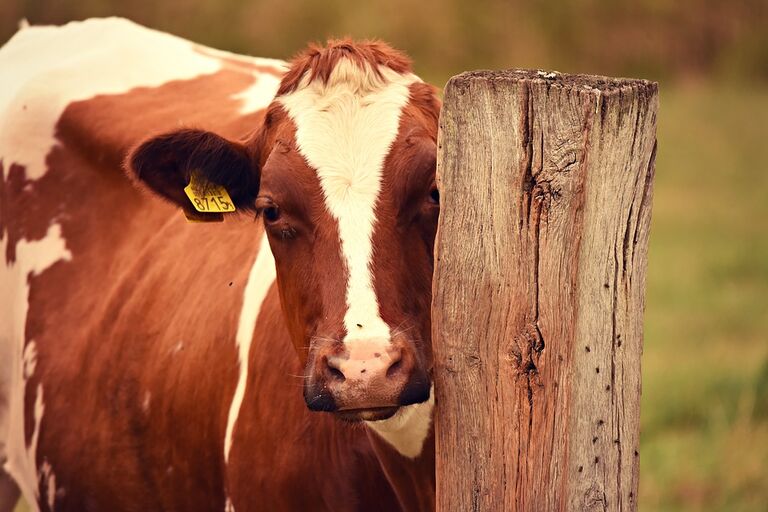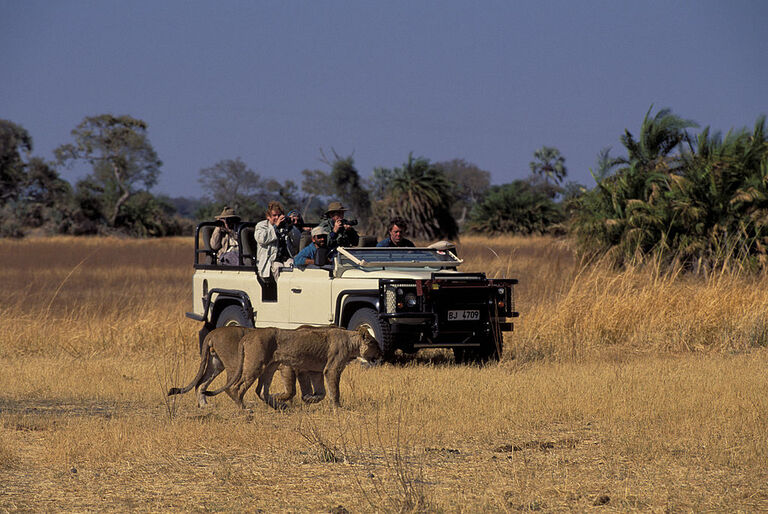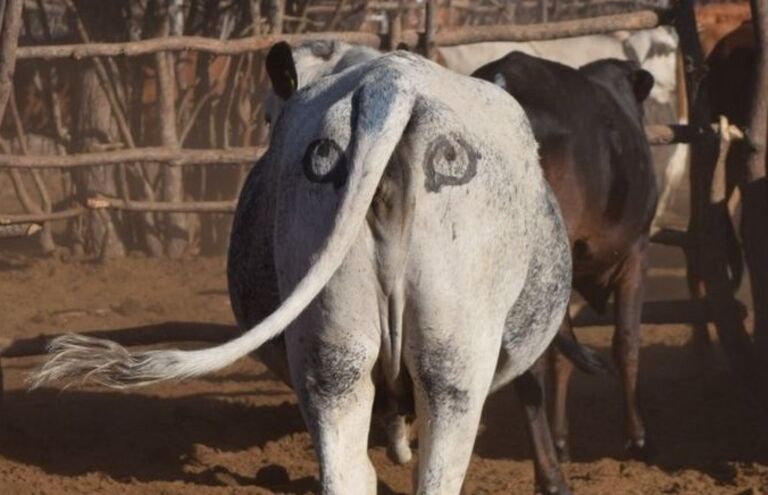The Reason These Cows Have Eyes Painted on Their Behinds Has Us Scratching Our Heads
Many think farming is just a bunch of old-fashioned traditions passed down from generation to generation. However, many innovative techniques are utilized on farms today.
Here’s a strange strategy that farmers have come up with: It involves painting eyes on cow butts. Although it sounds weird, it makes an enormous difference to their daily farming. It could even be revolutionary. Wondering how, exactly? Read on to find out.
The Hunting Instinct
If you’ve ever had the feeling that you’re being watched, you are not alone. The feeling is universal and stems back to our ancient caveman days. The phenomenon is referred to as “the watcher effect.”

Source: Paolo Torchio/Barcroft USA/Getty Images
Since our ancestors always had to be aware of their surroundings to survive, it’s no wonder that this feeling is still ingrained in our brains. It’s akin to a survival mechanism that kicks in when we sense that we’re being watched or followed.
The Life Of A Cow
We all have a natural instinct to escape a threat, perceived or otherwise. But it’s not always that easy. Cows especially find it difficult to move. Because of their size and naturally slow movement, it can be difficult for cows to get out of danger quickly.

Source: Max Pixel
But today, farmers have come up with a clever solution to keep cows safe using a psychological trick. Cows have a sedentary nature; they have a tendency to stay in one place. For that reason, they need to be protected.
Keeping Cows Safe
Cows are well known for being docile. Unfortunately, such a trait also makes them vulnerable in the wild. Since they are not fast or clever animals, they can easily fall prey to predators.

Source: Auscape/Universal Images Group via Getty Images
It’s no wonder that they are one of the most popular farming animals on the market. Cows are raised for meat, milk, and other by-products. But, because they are at a disadvantage in the wild, farmers had to devise effective ways to keep them safe.
On The Menu For Predators
In Botswana, cows are extremely popular amongst the lion population. Farmers needed to find ways to protect these gentle creatures from such dangerous predators. Lions see cows as a tasty meal and so will attack them quickly.

Source: Gideon Mendel/Corbis via Getty Images
This forced Botswana farmers to come up with ways to protect their cows. They’ve tried different methods, such as building fences to keep lions from getting near them. However, lions found a way to get around this hindrance, being naturally able to jump over barriers.
Team Cow Vs. Team Lion
We have to admit that we sympathize with a lion’s preference for beef. While we prefer our hamburgers well done, they are perfectly fine with consuming raw and fresh meat. However, we also feel for the plight of farmers in Botswana, as their cows are being killed indiscriminately.

Source: China Photos/Getty Image
If farmers can’t keep up with the lions’ taste for meat, their herds will be reduced to nothing in a short order of time. This is a huge issue for farmers in Botswana.
Thinking Outside The Box
Besides building fences, farmers also hired shepherds to guard their cows. They also placed the animals in smaller pastures. But these techniques only go so far. They had to come up with something more innovative.

Source: Gideon Mendel/Corbis via Getty Images
Fortunately, a team of researchers helped them to develop a rather intuitive idea that would not need to involve higher walls or rifles. They decided to try out their plan in 2015. The goal was to see if their unconventional strategy would work. The results were striking.
A Genius Plan From The Experts
It took expert researchers from Communications Biology to figure out an outlandish way to keep lions from attacking a herd of helpless cows. Despite the scientific nature of their group, their plan was odd, to say the least. But it was also backed by a high level of research.

Source: JamesAALongman/Twitter
The theory involved keeping cows alive using a little paint. Many thought their proposal was crazy, but these scientists insisted it was worth putting to the test. This was the result of their “prototype.”
Eyes Without A Face
An ecologist named Neil Jordan came up with the idea to have farmers paint eyes on the rear ends of their cows. It was difficult to take the plan seriously at first. Even to a layperson, the idea sounds like a joke.

Source: camthera/Twitter
But it’s not as crazy as it sounds. Dr. Jordan explained that the idea is based on animal behavior theory. It didn’t involve converting the cows into predators—it’s just a way to keep them safe from other animals who want to eat them.
The Secret Is In The Surprise
Dr. Neil Jordan, from the University of New South Wales, was part of a team of researchers that tested this theory in the field. They wanted to find out if painting eyes on cows’ rear ends could keep them safe from predators.

Source: HWConflict/Twitter
Their hypothesis was tested when they worked with a bunch of farmers in Botswana between 2015 and 2018. They recruited 2,061 cows and painted eyes on their rear ends. They also said the element of surprise was crucial for the experiment’s success.
Sit-And-Wait Predators
Lions like to surprise their prey. For this reason, they are often referred to as “ambush predators.” Their natural tendencies gave Dr. Neil Jordan and his team of researchers the idea to paint eyes on cows’ behinds.

Source: David Silverman/Getty Images
The idea is to catch a lion off guard the instant they come across a cow with a face painted on its butt. Anyone would be surprised if they saw eyes on the part of a body they aren’t supposed to be on.
Animal Psychology
Dr. Jordan and the rest of the researchers used animal psychology as the basis for their hypothesis. They hoped that if lions came across one of their painted cows, they would think the cow could see them and would be deterred from their hunt.

Source: Ahmed Alsayed/Anadolu Agency/Getty Images
It’s similar to psychological trickery but applied to animals. The eyes function as a decoy to make the lions think they’ve been spotted when in fact, the cows are actually oblivious. This works on other predators, not just lions.
An Evolutionary Strategy
Who would have thought that such a weird plan would make perfect sense? The idea of painting eyes on cows to protect them from predators might sound a bit odd, but it’s a common evolutionary trait in a lot of animals.

Source: Justin Sullivan/Getty Images
Many butterflies, fish, and birds have “eyes” on their wings, scales, and feathers to make them look more alert. They also used it to deter predators. It’s the same concept as placing eyes on the butt of cows.
The Feeling Of Being Watched
The feeling of discomfort in being watched is a universal feeling that has been successfully exploited before. When bike thefts became a big problem in many cities, designers tried using the “feeling of being watched” phenomenon to deter such thievery.

Source: melissasuzanneh/Twitter
In 2012, some people came up with an idea to put signs with a pair of eyes near bike racks. Believe it or not, it worked! The number of bikes being stolen decreased significantly. It’s as if the eyes made people think that they were being watched.
The Details Of The Experiment
Dr. Neil Jordan and his team of researchers applied their theory by splitting the 2,061 cows they recruited for the experiment. On a Botswanan farm, cows were split into three groups. One group had 683 cows that had eyes painted on their rear ends.

Source: HWConflict/Twitter
Meanwhile, another group had 543 cows that had cross marks. Then, the last group, which was left unmarked, had 835 cows. The idea was to see if the eyes or cross marks would have any impact on the cows’ safety from predators.
Different Colors
But how exactly do you paint eyes on a cow’s rear end? Dr. Neil Jordan and his team of researchers used a paint stamp to imprint the eyes onto the cows. They used different paints for each group of differently colored cows.

Source: BPCTcamp/Twitter
They used black paint on white cows and yellow on brown cows to make the “eyes” stand out. Then they observed the groups of cows and compared the results of the group with eyes painted on their rear ends, the “crossed” cows, and the control group.
Cow Casualties
The results collected by Dr. Neil Jordan and his team of researchers were impressive. The group without painted eyes saw 15 cow deaths from lion attacks—a remarkably high number. Meanwhile, the “crossed” group only had four deaths. That’s a good result.

Source: Yves GELLIE/Gamma-Rapho via Getty Images
But the experimental group, the one with the painted eyes, had zero deaths from lion attacks. They all survived without a scratch! The simple act of painting eyes on cows’ rear ends completely protected them from their deadly predators.
What Will Happen To The Lions?
As it turns out, the cows weren’t the only victims killed by predators. The lions are also indirectly affected by their own actions. When lions have a steady food source, they don’t work as hard to find other kinds of food.

Source: Gideon Mendel/Corbis via Getty Images
But when that food source is taken away, they will start hunting for other prey. Additionally, killing too many cows creates food scarcity. Protecting cows from predators is good for cows and the predators as well. It’s a win-win solution.
Lions As The Hunted
Dr. Neil Jordan reiterated that the idea of painting eyes on cows isn’t just about protecting the cows—it’s also about protecting the lions. He further explained that when lions kill cows, farmers lose money. Farmers then retaliate by killing the lions.

Source: Wolfgang Kaehler/LightRocket via Getty Images
He estimated that approximately 20 times as many lions are killed in retaliation compared to those taken by the trophy-hunting industries. Therefore, it has become necessary to protect cows from predators to save the dwindling lion population. Everyone wins.
A Cow Saved Is A Lion Saved
The solution Dr. Neil Jordan implemented was simple, but it had a huge impact on both the cows and the lions. With the help of African farmers and the Predatory Conservation Trust, their ideas became a regular part of farming.

Source: Nathan Pellow-Jarman/Barcroft Media via Getty Images
They understood that in Africa, a “culture of killing” exists when it comes to managing predators. It was a serious issue that required a solution that worked for all parties—the farmers, the cows, and the predators.
We’ve Only Just Begun To Understand
The experiment is still in its early stages, but researchers are doing their best to understand the fine details and exact mechanisms behind the results. They are beginning to understand more about how it works, including the unfortunate fact that it isn’t a universal solution.

Source: LohDown/Twitter
The painted eyes deceived even humans. But predators have an instinctual desire to hunt and will pounce on any prey they think they can take. It’s a fascinating concept that should be further experimented with as we all move into the future.
